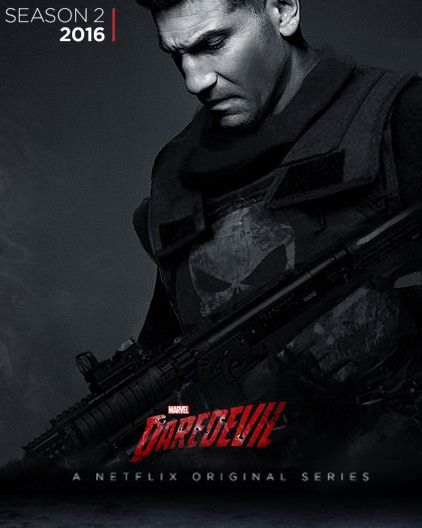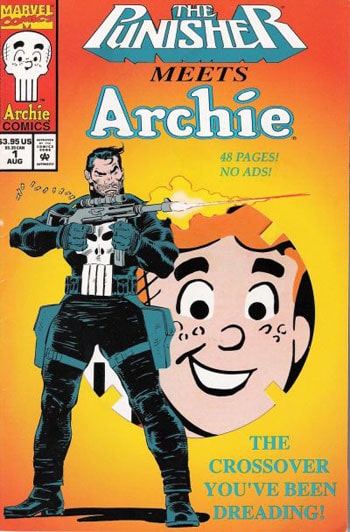First Appearance
Amazing Spider-Man #129 (February 1974)
Powers and Abilities
Possessing no superhuman abilities, Frank is a skilled soldier and hand-to-hand combatant. He’s accomplished in special forces operations, guerrilla warfare, and stealth tactics, and proficient in countless firearms, explosives, and melee weapons.
Gadgets and Accessories
Punisher uses a wide variety of weapons and gear to wage his war on crime, so much so that Marvel at one point published a series detailing his various weaponry (Punisher Armory). Punisher often travels in a van (his “battle van”) carrying assorted weaponry and surveillance supplies.
Friends and Allies
Microchip (David Liebermen, who provides tech support), Lynn Michaels (a police officer-turned-Punisher copycat), Lt. Martin Soap (the head of the NYPD’s anti-Punisher task force, secretly allied with Punisher), the Marvel Knights (a loose assortment of NY-based street level heroes with whom Punisher occasionally worked), Captain America’s Secret Avengers (the anti-Registration forces during the superhero Civil War).
Enemies and Antagonists
Jigsaw, Saracen, the Kingpin, crime, the 90s, assorted superheroes, including Daredevil, Wolverine & Spider-Man, at varying times, the countless criminals he’s executed through the years.
Movies and Appearances
The Punisher has starred in three feature films, played by a different actor in each: first, Dolph Lundgren in 1989, then by Thomas Jane in 2004, and finally Ray Stevenson in 2008’s Punisher: War Zone.
The Punisher appeared in three episodes of the 1990s Spider-Man animated series and one episode of The Super Hero Squad Show (voiced by Stevenson).
Jon Bernthal takes up the mantle in the second season of Netflix‘s Daredevil live-action series.

One Sentence Origin
Following the death of his family at the hands of the mob, army veteran Frank Castle declares war on crime, violently meting out justice as the Punisher.
Fun Fact
A testament to the character’s popularity and his ability to pop up anywhere as a guest star during the early 90s, the Punisher even crossed over with Archie Comics, in which Archie and the Riverdale gang helped the Punisher stop a drug dealer.

Austin’s Analysis
Debuting in 1974 as a pastiche (or outright ripoff, depending on who you ask) of Mack Bolan’s Executioner character, the Punisher existed for many years as, if not an outright super-villain, then a recurring antagonist for characters like Spider-Man and Daredevil. His violent, lethal approach (and use of guns) put him at odds with the moral codes of traditional heroes, who took firm stances against killing their foes. As the 70s turned into the 80s, and superhero comics got increasingly darker, with morally gray anti-heroes gaining in popularity, Punisher was poised for big things. He received his own miniseries in 1986, brought into existence by writer Steven Grant, artist Mike Zeck and editor Carl Potts over the objections of management at Marvel (who believed readers weren’t that interested in the character).
Needless to say, the miniseries was a hit, and within the next year, the Punisher received his own ongoing series. By the time the 90s rolled around, and the kind of take-no-prisoners, hard-edged attitude the Punisher had, in part, shepherded into superhero comics was all the rage, he was one of Marvel’s most popular characters (along with, arguably, Wolverine and Ghost Rider), at one point carrying three separate ongoing titles (almost on par with Spider-Man) – Punisher, Punisher War Journal, and Punisher: War Zone – along with Punisher Armory, a black-and-white magazine, and numerous one-shots, limited series, graphic novels & guest appearances in other comics.

But when the speculator bubble in comics burst in the mid-90s, the Punisher was one of the biggest causalities. The market could no longer support so many Punisher books, helped by lackluster creative teams and the fact that all those issues and appearances had watered down the character, resulting in increasingly dubious attempts to catch readers’ attention (such as the storyline in which the Punisher becomes African-American). In 1995, all of his ongoing series were cancelled. A relaunched title ran for 18 issues, until 1997. By then, the character was relegated back to limited series status, suffering under some truly dreadful re-imaginings of the character (Most notably, his stint as a resurrected angel wielding guns which shot hellfire.). It wasn’t until 2000, when Garth Ennis and Steve Dillion launched a 12 issue series under the new Marvel Knights imprint , featuring a deliberately back-to-basics version of the character combined with Ennis’ signature dark humor, that the character both seemed himself and attracted readers again.
Since then, Punisher has remained a viable character and maintained a consistent publishing presence, though his heyday of carrying multiple books and making routine guest appearances in all corners of the Marvel Universe are long behind him. And, really, that’s for the best: on his own, the Punisher is a compelling character. A shattered soldier, driven to extremes by the death of his family. He’s a Batman who eschews the theatricality of a costume and has no qualms about killing bad guys, and that type of character can be engaging and entertaining. But Punisher works less well as a protagonist in a shared superhero universe. Put him side-by-side next to guys like Daredevil or Captain America, and everyone gets watered down: the Punisher doesn’t kill anyone (because the heroes won’t let him), and the heroes look like idiots for not capturing this guy who willingly operates so far outside their usual “no killing” code.

Thus, the best way to use the Punisher in a shared universe is how he was originally conceived: as an antagonist. He doesn’t need to be a super-villain, but he should be someone the other heroes are trying to stop and are unwilling to work with in all but the most extreme circumstances (Thankfully, this looks to be the approach Netflix’s Daredevil is taking, at least initially.). The Punisher is unlike any other superhero, and those differences should be celebrated, not sanded down or outright ignored . Put the Punisher side by side with another superhero, and everyone suffers. Pit them against each other, use the Punisher as a means to examine the ethics of vigilantism and super-heroism, of choosing to take the law into your own hands but finding different points at which to put it back down, and everyone benefits.





